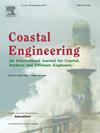礁滩跨岸剖面演变实验研究
IF 4.2
2区 工程技术
Q1 ENGINEERING, CIVIL
引用次数: 0
摘要
考虑到各种离岸波浪条件和礁石环境,对礁前海滩的跨岸剖面演变进行了物理实验。实验分析了海滩跨岸剖面演变、沉积物运移速率以及海滩趾部的波浪。研究发现,礁石面海滩对近海沉积物运移引起的侵蚀具有较强的抵抗力。在目前的情况下,海滩会从倾斜剖面演变为反射剖面,而陆上沉积物迁移则会导致斜坡护堤的形成。海滩趾部的短波和次重力波对海滩形状的形成起着重要作用。护堤前滩坡度主要取决于滩趾次重力波段的波能密度。滩趾短波波段的波能密度随礁石浸没度的增加而增加,而滩趾次重力波段的波能密度则随离岸波高的增加而增加。沉积物迁移率的时间演变呈现出两种模式,这意味着斜流与海滩剖面演变之间存在复杂的反馈作用。礁前海滩上的大体积输运由短波的相对高度以及海滩趾处短波和次重力波的波陡参数决定。提出了一个海滩上体质输运的概念模型,即体质输运随 Gourlay 数的增加而增加,这表明具有发达礁石平地的礁石面海滩对不断增加的波浪暴露具有弹性。本文章由计算机程序翻译,如有差异,请以英文原文为准。
Experimental investigation on cross-shore profile evolution of reef-fronted beach
Physical experiments on cross-shore profile evolution of the reef-fronted beach are conducted considering various offshore wave conditions and reef settings. Cross-shore beach profile evolution, sediment transport rate, and waves at the beach toe are analyzed. The reef-fronted beach is found to be resilient to erosion induced by offshore sediment transport. In present cases, the beach evolves from a sloping profile to a reflective profile, and onshore sediment transport leads to the formation of a swash berm. Both the shortwaves and infragravity waves at the beach toe play an important role in forming the beach shape. The berm foreshore slope mainly depends on the wave energy density in the infragravity band at the beach toe. Wave energy density in the shortwave band at the beach toe increases with reef submergences, while wave energy density in the infragravity band at the beach toe increases with offshore wave heights. The temporal evolution of sediment transport rate exhibits two modes, implying complex feedbacks occur between swash flows and beach profile evolution. The bulk transport on the reef-fronted beach is parameterized by the relative height of shortwaves and wave steepness of both shortwaves and infragravity waves at the beach toe. A conceptual model of bulk transport on the beach is proposed that the bulk transport increases with the Gourlay number, indicating that reef-fronted beaches with a well-developed reef flat are resilient to increasing wave exposure.
求助全文
通过发布文献求助,成功后即可免费获取论文全文。
去求助
来源期刊

Coastal Engineering
工程技术-工程:大洋
CiteScore
9.20
自引率
13.60%
发文量
0
审稿时长
3.5 months
期刊介绍:
Coastal Engineering is an international medium for coastal engineers and scientists. Combining practical applications with modern technological and scientific approaches, such as mathematical and numerical modelling, laboratory and field observations and experiments, it publishes fundamental studies as well as case studies on the following aspects of coastal, harbour and offshore engineering: waves, currents and sediment transport; coastal, estuarine and offshore morphology; technical and functional design of coastal and harbour structures; morphological and environmental impact of coastal, harbour and offshore structures.
 求助内容:
求助内容: 应助结果提醒方式:
应助结果提醒方式:


